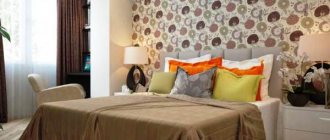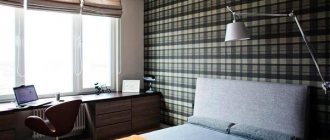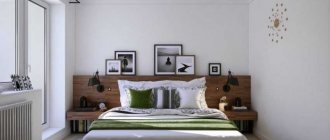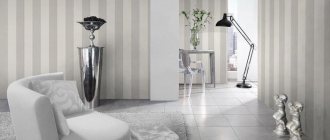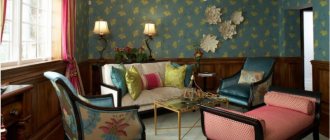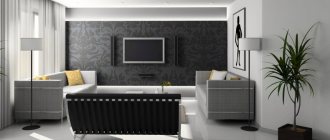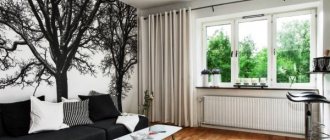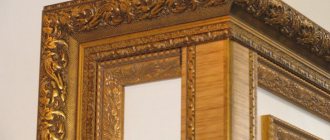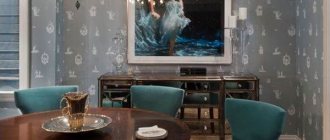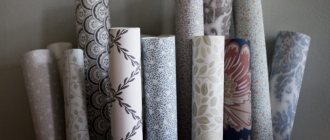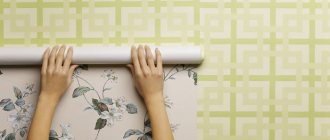In the line of wallpapers with special characteristics - fire-resistant, anti-vandal and so on, eco-friendly wallpapers occupy a special place. They are associated with the most myths, misunderstandings and even outright deception. As the demand for environmental friendliness has only increased in recent years, any manufacturer is trying to add the prefix “eco” to the name of its products.
However, in practice it turns out that the environmental indicator is not as simple as it seems at first glance. Most often, this characteristic refers to the safety of wallpaper for people, and only in some cases is it extended to further issues of disposal and safety for nature in general.
Questions are also added by the fact that the environmental friendliness of wallpaper in a roll and wallpaper pasted on the wall can vary greatly. What characteristics should a natural and safe fabric have? What wall coverings cannot harm you? Is it worth pursuing environmental friendliness, or does it have its drawbacks? Let's figure it out further.
What is eco-friendly wallpaper?
Issues of environmental friendliness of a particular finishing or building material are very subtle. Construction technologies are changing, safety requirements are increasing, people’s knowledge about their health and substances hazardous to it is increasing - and now materials previously considered safe are labeled “harmful”.
Therefore, most people give preference to long-known finishing materials and materials with a large proportion of natural ingredients. But is it worth relying on this? So, let's take it in order.
First of all, environmental friendliness means the safety of wall decoration for humans. Formally, all wallpapers officially approved for sale meet these requirements. But this does not mean that the issue can be closed. A number of important conditions must be taken into account:
- Wallpaper in a roll and wallpaper on the wall are two different units. To wallpaper on hay, glue is added, which is specialized for each type of roll finishing, and finishing (coating with paint or wax, water-repellent impregnation or other means).
- The environmental friendliness of the coating should not be at the expense of their decorative qualities. Plain paper rolls, unbleached and undyed, are the most environmentally friendly option. But within a year, or even earlier, they will turn yellow from exposure to sunlight, become stained from indelible dirt, and tear in places where the paws of animals or the inquisitive hands of children can reach them.
- Over time, environmentally friendly wallpaper may well become harmful. This will happen if thick “non-breathable” wallpaper is pasted on the wall without pre-treatment with fungicides: sooner or later fungus will grow behind it. The same problem exists with natural wallpapers - they are happily eaten by various domestic parasites, which can cause allergies in people. And if the canvas is processed so that it becomes “tasteless”, will it still not be harmful to human health?
- Eco-friendly wallpaper should maintain its characteristics in different conditions: temperature, humidity and sunlight. They must be “sustainably green”, so to speak. And, at the very least, they must have the ability to restore their environmental friendliness.
Therefore, instead of the not entirely clear “safety for people,” when choosing environmentally friendly wallpaper, you should focus on the following series of characteristics:
- No release of harmful substances into the atmosphere of a living space;
- Ease of cleaning dirt and returning the original appearance;
- Maintaining characteristics when changing environmental conditions: temperature, light, humidity;
- There is no need for additional processing, which reduces the environmental properties of the wallpaper;
- Long service life without changing the original qualities of the material;
- Compliance with the design goals of the room, high decorative characteristics.
It is easy to notice that now the level of requirements for the environmental characteristics of wallpaper has increased significantly. Luckily, there are wallpapers that match them.
Which products are environmentally friendly?
What wallpapers are considered eco-friendly? First of all, they should not contain vinyl, this is important for the following reasons:
- Vinyl wallpaper releases volatile substances of the phenolic group for some time after gluing.
- During the production process, toxic waste is generated that negatively affects the environment.
- When heated strongly, it also releases harmful elements.
In addition, the composition should not contain synthetic dyes, formaldehydes, heavy metals and adhesives.
Types of eco-friendly wallpaper, their advantages and disadvantages
There is a common misconception that the simplest and cheapest wallpaper is the most environmentally friendly. This is wrong. Currently, many cheap finishing materials are produced, but they are not environmentally friendly and are often even harmful to humans. As a rule, the more expensive the material, the more environmentally friendly it is.
However, it would be wrong to focus only on price. Below we provide a list of wallpapers with high environmental characteristics, without keeping silent about their shortcomings:
- Natural plant wallpaper: reed, algae, bamboo, cork
Wallpaper made from natural materials is very expensive, but of high quality. This is a whole segment of roll wall coverings, which are intended for people who primarily value the naturalness and high functional characteristics of plant materials. The advantages of natural wallpaper include high heat and noise insulation, excellent decorative properties, and environmental safety of the base material.
But they also have disadvantages. As a rule, this is an elite segment of finishing materials with a very high price. Such wallpaper still requires the use of adhesives, pigments and impregnation, although of very high quality and with minimal harmful effects. Vegetable wallpaper, except for cork wallpaper, can also fade quickly, so it is not suitable for rooms with a high degree of illumination.
- Paper wallpaper
At the other price pole are paper wallpapers. Typically, they occupy the lowest price segment of all types of rolled wall coverings. The exception is eco-wallpaper with natural pigments and minimal processing of the paper base. Such wallpapers cannot be called cheap, but, unfortunately, they are the only ones capable of meeting a number of requirements for product safety.
The environmental friendliness of cheap paper wallpaper is, in many cases, a myth. The paper base of such wallpaper is fragile, so it has to be treated with various compounds to increase wear resistance. This includes treatment to improve UV resistance and lamination to improve anti-vandal properties. The pigment on the top layer of paper wallpaper is sometimes so unstable that it can be wiped off even with a dry cloth. They have the ability to absorb odors and harmful substances, such as cigarette smoke.
From all of the above, we can conclude that paper wallpaper is certainly environmentally friendly, but only in the highest price segment. In addition, you should not count on the long service life of such wallpaper, no matter what quality it is.
- Liquid and textile wallpaper
Liquid and textile wallpapers are based on plant fibers: linen, cotton, silk. They are durable, decorative and durable, however, their environmental qualities depend on other components: glue (for liquid) and synthetic fibers (for textiles). In general, it can be noted that such materials with natural fibers are a good choice for dry rooms with controlled humidity levels. But in rooms with high humidity they will be the basis for the spread of mold, so for damp apartments it is better to choose another option.
- Non-woven wallpaper
Non-woven wallpaper is made from pure cellulose, but its environmental friendliness must be judged by its outer coating. Often, interlining is not used in its pure form, but as a basis for a decorative vinyl layer, and this is a synthetic material, the safety of which is doubtful. Therefore, we can talk about environmentally friendly non-woven wallpaper only if it is intended for painting. Then they have all the advantages of the original material: strength, excellent gas exchange (the walls “breathe”), and the absence of substances harmful to humans. It is worth noting that the cost of such wallpaper is quite high.
- Glass wallpaper
Glass wallpaper is a finishing material that not only meets the highest safety requirements, but also retains its characteristics for its entire service life. In addition to being fire-resistant and damage-resistant, the glass threads that form the basis of glass wallpaper can be cleaned with almost any type of detergent. Therefore, it will be very easy to restore the original appearance if they become dirty or smoked. This is especially true for rooms such as a children's room or kitchen.
Fiberglass wallpaper does not contain organic inclusions, which so often fail textile and vegetable coatings in conditions of high humidity. They are many times superior to paper wallpaper in terms of durability and wear resistance, and non-woven wallpaper - in terms of reinforcing properties. In a word, if you had to choose an environmentally friendly champion among rolled materials, it would be glass wallpaper.
Price
Finally, I will give the cost of all the above coatings:
| Wallpaper type | Price in rubles per roll |
| ICH Elegance paper | 2600 |
| Turin Pulp and Paper Mill, Quadro, paper | 540 |
| Smile, paper | 300 |
| BN Art of Living, non-woven | 1800 |
| Andrea Rossi Ishia, non-woven | 2900 |
| Vescom Stars-Crystallized, fabric | 7500 |
| Atlas, fabric | 5500 |
| Cork | From 2700 |
Fabric wallpaper Vescom Stars-Crystallized
The prices in the table are valid for winter 2017/2018.
How to maintain environmental friendliness of wallpaper when pasting?
It was already said earlier that one should separate the pure environmental friendliness of a roll of wallpaper and its environmental friendliness after gluing it to the wall. In the latter case, glue, primer and paint, and sometimes wax and various impregnations, add their characteristics to the wallpaper. Additional components can significantly reduce the initial safety of wallpaper, so if the choice of wall decoration is based on safety indicators, it is worth paying attention to them.
Water-based paints are considered the best from an environmental point of view, which are recommended for residential premises, including bedrooms, as well as children's institutions - playrooms, assembly halls. But you need to choose the glue that is offered by the wall covering manufacturer.
Quite often you can come across advice to add reinforcing components to wallpaper glue. Based on this recommendation, buyers choose inexpensive glue, strengthening it with additives at home. Or just “to be sure” they are added even to the recommended adhesive compositions. This is definitely not worth doing.
If you want to preserve all the environmental qualities of the purchased wallpaper, you will also have to abandon the various impregnations and coatings that are applied after gluing the wallpaper to the wall.
Why is this becoming increasingly important?
Beginning in the mid-20th century, wallpaper manufacturers began to add so-called “improvements” to their products: vinyl or PVC, formaldehyde, chemical dyes, fungicides and powerful adhesives. Thanks to these additives, wallpaper acquired amazing properties: high strength, light and water resistance, durability, etc.
Unfortunately, with all this there are by-products - volatile organic compounds (VOCs). These are toxic gases that are emitted by various solvents, plastics, paints and adhesives contained in wallpaper. They can cause occasional headaches, dizziness, blurred vision, memory loss, respiratory problems, and even liver or kidney problems. By being careless in the selection of different materials for your home, you can cause serious damage not only to the environment, but also to your health.
Vitrulan glass wallpaper - the best choice of environmentally friendly wallpaper
Vitrulan is a leading European manufacturer of glass wallpaper, one of the world leaders in the production of fiberglass finishing materials. High requirements for the quality of raw materials and manufactured products, which undergo European certification, allow us to declare the absolute safety of glass wallpaper for humans.
Vitrulan glass wallpaper, due to its excellent quality characteristics, can improve gas exchange in rooms, reinforce walls, reduce the spread of small and large cracks, and prevent the appearance of fungus on wall structures. They can be glued to almost any wall - brick, concrete, foam blocks, drywall, etc., naturally, having first leveled and primed it.
In addition to environmental safety, Vitrulan offers a wide selection of textures, patterns, the ability to create exclusive photo wallpapers, and painting in any colors - from white and gold to red, purple and black. Divided into “economy” and “luxury” series, you can choose wall finishes of unsurpassed quality for different budgets.
Vitrulan is a glass wallpaper that allows you not to make compromises, but to choose the best wall covering in terms of beauty and functionality. Choose Vitrulan glass wallpaper to be confident in the safety of your health!
The online store "Wall" offers to buy high-quality glass wallpaper from the official dealer of the German company Vitrulan - wholesale and retail, with pleasant discounts, favorable conditions for delivery and pickup in Moscow and the Moscow region.
Selection rules
- It is necessary to pay attention to the base material. The less chemicals it contains, the safer the wallpaper is for walls.
- You need to find out about the origin of coloring pigments and the protective top layer. Most often, inexpensive synthetic products are not environmentally friendly. They are produced using cheap raw materials, which can be toxic.
Attention! Despite the assurances of manufacturers, materials from a low price category cannot be completely safe for health, since when creating such products they save on literally everything: on raw materials, equipment, and control.
- It is very important to check for a quality certificate. If it is present, it means that the products were not made using a handicraft method. The certificate also indicates the composition of the material and its purpose.
Stickers and inscriptions “Eco”, “Natural product” are just marketing; in fact, the law does not regulate the use of such labels.
In addition to choosing the right wallpaper, you need to make sure that other materials are harmless to health. This applies to glue, putty and primer.
Cork and other coverings
This material also has a paper base and has high antistatic properties. Unlike many other coatings, they are not exposed to UV rays and retain their original appearance for many years.
Particular originality is given to the interior by coverings made of genuine leather, as well as glass wallpaper based on quartz sand, soda and lime. Any of the finishing materials will not only make the interior exclusive, but will also protect against allergies, fungus, and mold.
Related article: DIY crafts from autumn maple leaves (44 photos)
Wallpaper for a classic bedroom
Recommendations for purchasing
You need to take your choice seriously. Purchasing a low-quality product will be a waste of money. Here are four points to guide you:
- 1) The first is the presence of markings.
- 2) The second is a quality certificate, which also indicates the composition of the product.
- 3) Third - physical properties. A pungent smell, weak strength, which can be checked in a simple way (run your fingernail over the surface), indicate poor quality of the product.
- 4) Finally, the fourth guideline will be the price: you should not save. Otherwise, there will be even more costs in the future.
Domestic or “Eco Material” products, products from Scandinavia are labeled “White Swan”, from Germany – “Blue Angel”, and other European Union countries – “EU Flower”, from the USA – “Green Mark”, from Canada – “Ecological Choice” ", from Japan - "Eco sign".
Caring for environmentally friendly wallpaper and operating features
Many natural materials absorb odors and deteriorate when exposed to water. Finish varnish coatings and wax impregnations help extend the service life.
Paper wallpapers are the most difficult to maintain. Soft feather brooms, whisks, and brushes are used for cleaning. You can use an eraser. Paper wallpaper is delicate. Dirt is removed with smooth and light movements of the eraser. Grease stains are removed with a cloth heated with an iron.
Dust-repellent impregnations are also used.
Eco-friendly wallpaper is expensive, but its price is justified by its useful properties, durability, and practicality. They are varied in materials and their appearance is varied. Universal: used in kitchens, bedrooms, living rooms. They give the room natural harmony and pristine beauty of nature, fit into the eco-interior of a house or apartment.
